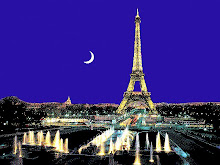A cemetery - different aspects
Labels :
André Breton,
Batignolles,
Cimitière des Batignolles,
Gaston Calmette,
Paris 17,
Paul Verlaine

This is about our local cemetery, Cimetière des Batignolles. It was opened in 1833, for the “locals”. It is not as full of tombs of well-known people as e.g. Père Lachaise, Montmartre, Montparnasse…, but I will revert to this.
It’s the fourth biggest of the totally twenty Paris cemeteries and has some 15 000 graves. It’s obvious that today the cemeteries within the city limits are not sufficient and that many of the larger ones now can be found in the suburbs. Also, the number of cremations in France has increased from close to zero to almost 30% the last 25 years. This is still a much lower percentage than in e.g. UK, Switzerland, Sweden… where cremations represent some 70-80%.
 Somehow, this is linked to what struck me during my visit; the great number of abandoned graves, which however often are the ones where the most beautiful flowers, getting wild, are growing! I took some pictures also of those! Most of us are not anymore linked to anywhere and in any case, our family and friends are often elsewhere…
Somehow, this is linked to what struck me during my visit; the great number of abandoned graves, which however often are the ones where the most beautiful flowers, getting wild, are growing! I took some pictures also of those! Most of us are not anymore linked to anywhere and in any case, our family and friends are often elsewhere…
It’s the fourth biggest of the totally twenty Paris cemeteries and has some 15 000 graves. It’s obvious that today the cemeteries within the city limits are not sufficient and that many of the larger ones now can be found in the suburbs. Also, the number of cremations in France has increased from close to zero to almost 30% the last 25 years. This is still a much lower percentage than in e.g. UK, Switzerland, Sweden… where cremations represent some 70-80%.
 Somehow, this is linked to what struck me during my visit; the great number of abandoned graves, which however often are the ones where the most beautiful flowers, getting wild, are growing! I took some pictures also of those! Most of us are not anymore linked to anywhere and in any case, our family and friends are often elsewhere…
Somehow, this is linked to what struck me during my visit; the great number of abandoned graves, which however often are the ones where the most beautiful flowers, getting wild, are growing! I took some pictures also of those! Most of us are not anymore linked to anywhere and in any case, our family and friends are often elsewhere… To some of you, a few names of the local people buried here may say something: Paul Verlaine, one of the greatest French poets, Blaise Cendrars another poet, Edouard Veuillard, painter…
To some of you, a few names of the local people buried here may say something: Paul Verlaine, one of the greatest French poets, Blaise Cendrars another poet, Edouard Veuillard, painter…You can also find the tomb of André Breton, the main founder of surrealism - linked to other writers and also painters like Salvador Dali. (André's grave is the one with an empty champagne bottle on it; someone drank to his health and then put a small flower in the bottle.) One small “anecdote”: When travelling in Mexico, Breton met Diego Rivera, Frida Kahlo… and Trotsky, with whom he co-wrote a manifest.
The tomb you can see under a later built bridge is that of Gaston Calmette, boss of “le Figaro”, who was shot dead in 1914 by the wife of a French minister - a big scandal at that time. Gaston was the brother of Albert Calmette, who was the father of the BCG vaccine against tuberculoses and also developed the first snakes’ antivenin.














23 comments:
I was at all times impressed by the touristy aspect of Parisian cemeteries. My favourite is the P�re Lachaise, and I�ve even posted on it at http://blogtrotta80s.blogspot.com/2006/07/strolling-outside-central-paris-st.html
But your Batignolles patchwork is quite surprising, as always.
les vieux cimetières ont une âme, une sorte de vie, d'ambiance. Et puis, on y rencontre des ecrivains, des poetes. A New York (dans le Bronx), il y a le Woodlawn cemetery, où tu rencontres les tombes des plus grands Jazzman, avec un peu d'imagination tu peux entendre le plus beau des concerts. apres cette digression, je te souhaite un bon weekend
As soon as I have finished tagging you on my blog today, I'll come back and read about cemeteries.
Old cemeteries are beautiful, now we lost the beauty of the dead.
Please note that I don't want to be buried, I want to be cremated and thrown away. Have you told your family your about your wishes? It may be important for them to know.
hpy:
Yes, the same. (The percentage will increase.)
Peter, tu es un vrai registre des cimetières...
Blaise Cendrars le poète manchot est certes beaucoup moins connu que Verlaine
Tu vois tous ces événements qui ont fait la une et dont ne parle plus...
Que de tombes désertées, les vrais personnes qui ont marqué restent.
Quoique... Je t'ai déjà parlé de la tombe de Maupassant ? Baudelaire, oui, sa tombe est fréquentée en plus aisée à trouver au cimetière Montparnasse. Qui lit Maupassant de nos jours sinon les littéraires et moi qui l'adore ?
Merci de tes recherches sur Paimboeuf, je t'ai fait copuié-collé de ma réponse à ce sujet à chamay lors de mon dernier post sur ce phare et ce port :
"Les bateaux sortant du port de Nantes, grand port du temps de la marine à voile faisait le plein de pain et de boeuf à Paimboeuf avant de prendre la haute mer. Le port de St Nazaire n'existait pas: c'était un marécage.
(Source: mon mari)"
Je ne suis pas sure que cela soit la vraie origine mais elle est parlante
En suédois et en français "boeuf" a la même racine alors. Mais c'est courant que les langues s'influencent mutuellement aussi
Bonne journée et bon week end Peter, la semaine a été courte pour moi...
hey! me too, I don't want to be buried I want to be dissected
I liked your photographs, Peter, and I like some of the tombstones you photographed.
I think you touched on a serious problem everywhere. What happens to buried people? They are supposed to be left in the ground.
Here you must buy the space and have a deed to it like you would have for a house. But in two hundred years there is nobody alive who knows you or even heard about you, so the locals are free, more or less, to do what they do.
Some people, like the people buried in Egypt, are no longer in their tombs but are scattered all over the world in museums. I am not sure that is the right thing to do but it happens.
Abraham Lincoln
Brookville Daily Photo
Different countries, different regions, different religions, different traditions... and traditions that are vanishing, sometimes for the good, sometimes for the bad. I already said above that personally I would like my ashes to blow away in the wind!
cergie:
Je suis revenu sur le "bo" et le "boeuf" sur ton blog.
Maupassant était mon premier favori quand j'ai commencé à apprendre le français - fortement recommendé par le prof! Je l'aime toujours, je crois, mais ça fait longtemps que je n'ai pas lu. Ca tombe bien, je viens de finir un bouquin cette nuit et j'ai cinq Maupassant dans ce qui reste de ma bibliothèque.
Cemeteries always hold a special fascination, don't they! Especially when there are so many "famous" or notable personalities. On the other hand, the cemetery in Wisconsin where several generations of my family lie buried, the small piece of land is restful and a lovely place to visit. My children when small were amazed at the tombstones holding similar names as theirs (ancestors) when we first visited the delightful little hamlet in which the ancestors were entombed. I, too, am going up in smoke, but it's not quite the same for subsequent descendants, is it?
Kate:
Yes, I believe things might be different if we all, one generation after the other, lived in the same village, but we don't any more - and in the big cities, there are so many of us.
what a big contrast !!! another great post of you, Peter.
Wishing you a nice weekend.
Thank you for sharing the sacred land of the deceased Peter....very interesting and appreciate you sharing with us.
Due to land & space constraint, alot of cemeteries were exhumed for other development.
Wow! Did not realize there are 20 cemeteries within the city of Paris!
My relative expressed her wishes to be cremated (after her death, of course ;-)), but her grandkids were so upset with the thought of not being able to "visit" her, she caved in (pun intended!) and is now buried in a cemetery. So far, no grandkids visited...
nice blog
I, like so many, enjoy wandering through graveyards, reading inscriptions, imagining lives and deaths. It's true, as you say, that old cemetaries, often neglected, offer great beauty.
I love cemeteries and this must be a wonderful one. It looks so full of life and the colors are vivid. When I visited Père Lachaise I was very disappointed: so much stone, no green. But this here looks great. Who cares about famous persons? Not me.
it's so serene....good enuff for a picnic..
C'est romantique de boire à la santé d'André (ou à la santé de ce qui boit lui-même?), mais on aurait pu lui laisser un peu de champagne, non?
I don't know why, but I like to visit cemetery place and to watch, read and as you take care about abandoned graves.
Thanks for this great post and photos.
La nouvelle de Maupassant que je préfère raconte l'histoire d'une famille où on oblige le grand père à manger pour sa santé et à la fin on l'empêche de manger le dessert qu'il aime pour sa santé car il a trop mangé avant
J'aime Maupassant car il décrit si bien la nature humaine
Petrer, je suis rentrée trop tard hier, alors ne t'inquiète pas : je ne publierai de nouveau que demain
Post a Comment